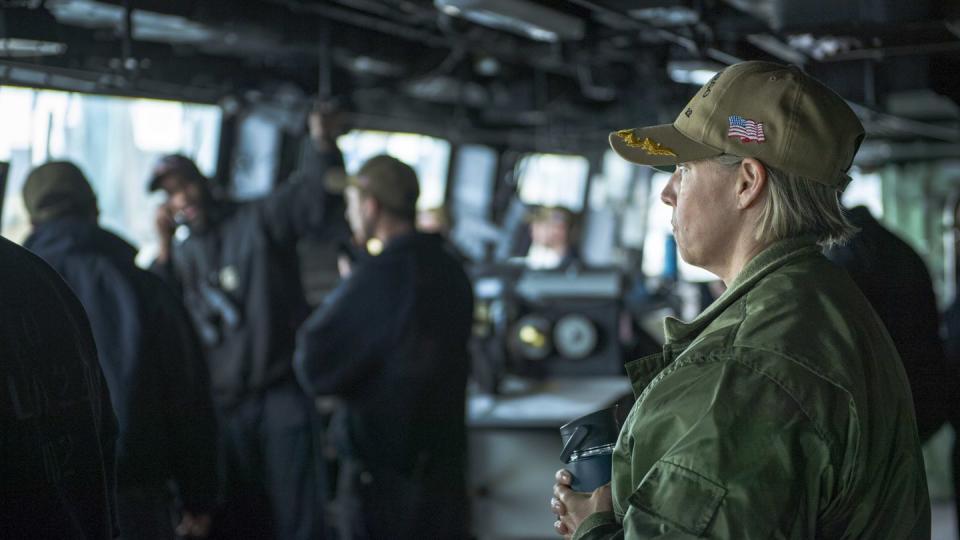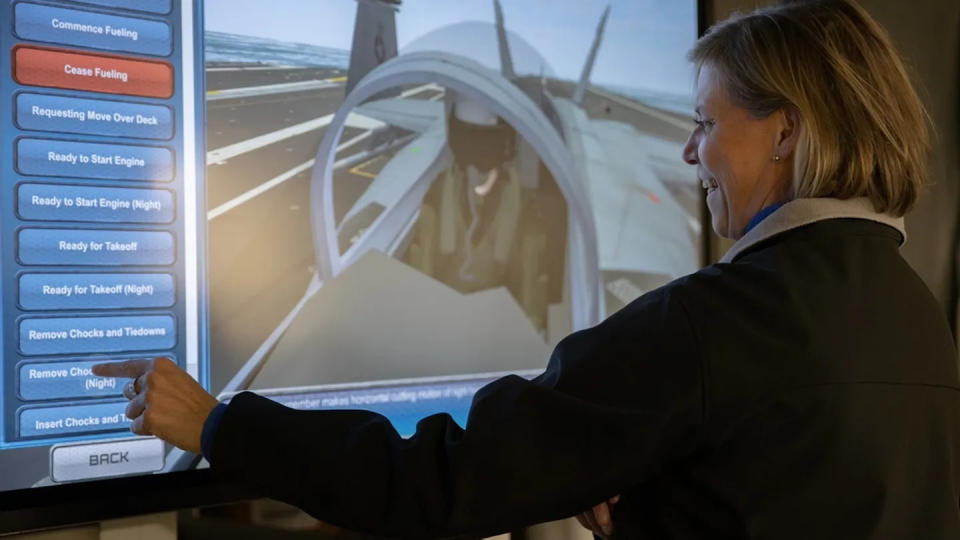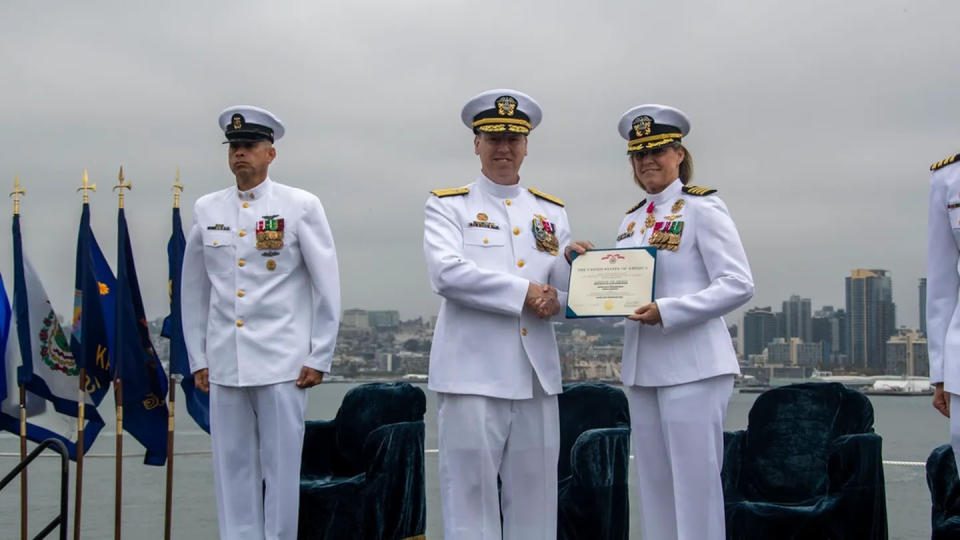She was the first woman to lead an aircraft carrier. Who is next?
Two phone calls changed Capt. Amy Bauernschmidt’s life.
First, when she found out she was in the pipeline to become a commander of an aircraft carrier in 2014. And second, when she learned she would be the first woman in the history of the U.S. Navy to lead a nuclear powered aircraft carrier in 2020.
But it’s unclear when another woman will get that call.
“There still isn’t another female in the pipeline,” Bauernschmidt told Navy Times. “There was nobody in the pipeline when I entered it, and there’s still nobody in the pipeline.”
Ensign Bryan Blair, a spokesperson for Commander, Naval Air Forces, confirmed that it would be at least another six to eight years before another woman takes the lead of a carrier after entering the pipeline, which starts at Nuclear Power School.
“Though there are currently no women in the aircraft carrier commanding officer (CO) pipeline, it is our hope that Capt. Bauernschmidt’s success as CO of USS Abraham Lincoln (CVN 72) will encourage and inspire our women aviators to pursue aircraft carrier command as a career path,” Blair said in a statement to Navy Times.

And even if another woman were to enter the pipeline, it’s not a guaranteed path to becoming CO of a carrier.
“Just by virtue of the length of the pipeline, and the process that you have to go to to get to this point is never a given,” Bauernschmidt said.
Bauernschmidt made Navy history with the likes of Vice Adm. Sara Joyner, who became the first woman to command a carrier air wing as a captain in 2011, and retired Vice Adm. Nora Tyson, who became the first woman to lead a carrier strike group in 2010. But Bauernschmidt is eager for the day that such milestones don’t exist anymore.
“I look forward to when we don’t have to celebrate firsts anymore,” Bauernschmidt said.
Joining the Navy
Bauernschmidt, who grew up in Milwaukee, Wisconsin, wanted to pursue a career that complemented her interests in math, sciences and the water. As she searched for colleges, she learned only a handful of schools offered a degree in ocean engineering – including the U.S. Naval Academy.
The school intrigued her, and Bauernschmidt spent a year in Rhode Island attending the Naval Academy Preparatory School, which aims to train midshipmen candidates through academic and physical programs for a life at the service academy, prior to heading to Annapolis.
Her time at the prep school, known as NAPS, provided a more seamless transition from civilian to military life.
“NAPS is perfect because you’re wearing uniform, you go into class, but it’s not as strict as being a midshipman…You really kind of get a dry run of your first year at the Naval Academy,” Bauernschmidt said.
This Navy captain is now the first woman commanding a nuclear aircraft carrier
Ultimately, Bauernschmidt graduated from the U.S. Naval Academy in 1994, just months after Congress repealed laws prohibiting women from serving on combat ships and aircraft. That decision played a role in Bauernschmidt’s choice to pursue a career in aviation, she said.
“There are incredible women all over the Navy now that are only there because they were able to take advantage of the new opportunities after that act passed,” Bauernschmidt said. “And so most of the awesomeness that you’re seeing in 2023 is because of that act passing.”
But it was the rigors of flight school that she said helped point her toward success, which then paved the way for her success at Nuclear Power School.

“It was really naval aviation that taught me how to study,” Bauernschmidt said. “You’re in an aircraft, you’re flying in and an emergency comes up. When you’re in an emergency, there’s no time to pull out a book. And so you needed to know the information and your systems and your procedures cold. And that’s where I really learned how to study.
“I took so many aspects of how I studied to become a pilot when I went to nuclear power training,” Bauernschmidt said. “If I had not had the experience of being an aviator, I would not have done well at Nuclear Power School.”
Bauernschmidt earned her wings as a naval aviator in 1996, and became a helicopter pilot assigned to Helicopter Anti-submarine Squadron Light 45, the “Wolfpack,” in San Diego.
She also served as an instructor pilot and quality assurance officer with the “Seahawks” of HSL-41 in San Diego, as well as the commanding officer of Helicopter Maritime Strike Squadron 70 – totaling more than 3,000 flight hours during her career.
Leading the Lincoln
Bauernschmidt took command of the Lincoln in August 2021, following a tour as the commanding officer of the amphibious transport dock San Diego.
Less than two weeks later after taking the lead, Bauernschmidt faced one of the most challenging moments of her career when a MH-60S Seahawk helicopter assigned to the Lincoln crashed while conducting training – killing five sailors. She wears a patch on her jacket honoring the five servicemembers who died.
A Navy investigation found that a damaged damper hose failed, causing the helicopter to vigorously shake as it was landing aboard the carrier, ultimately sending it into a spin that caused the aircraft to fall into the ocean.
Bauernschmidt recalled talking to sailors days after the mishap, their “awe-inspiring” ability to internalize the tragedy and their ability to have conversations about it.
“The team on board here did an absolutely incredible job and that professionalism, ownership of the mission, ability to do the right thing … continued throughout this tour, which was definitely a highlight,” Bauernschmidt said.
The carrier and its strike group set out on deployment in January 2022 to the U.S. 7th Fleet, where it conducted dual-carrier operations in the South China Sea with the Carl Vinson carrier strike group. The carrier also served as the flagship during Exercise Rim of the Pacific in July 2022, the world’s largest international maritime exercise conducted near the Hawaiian Islands and Southern California.
The biennial exercise involved 26 nations, 38 surface ships, and more than 25,000 personnel, who conducted what the Navy dubbed the most “realistic, relevant combined operations training.”
For the first time, the exercise embarked two U.S. Marine Corps MV-22 Osprey aircraft on Australian amphibious ship HMAS Canberra and also embedded MQ-9A and MQ-9B unmanned aerial vehicles.
“RIMPAC – there is no maritime exercise in the world like it, and the ability to so flawlessly work together for a period of about five weeks is truly impressive,” Bauernschmidt said.
Another milestone from the deployment for Bauernschmidt was the team’s ability to adapt after going more than 60 days without a port visit while navigating a high-risk environment.
“It was not a COVID thing. It was a mission thing,” Bauernschmidt said. “We were out there doing what our country had asked us to do. And the sailors did not complain, and they did not skip a beat, and they performed exceptionally well.”
Additionally, the Lincoln and its strike group were the first to deploy a Marine Corps F-35C Lightning II squadron: Marine Fighter Attack Squadron 314.
The squadron became ready for a carrier deployment and full combat operations in July 2021, and concluded a final integrated training cycle with the Lincoln and the carrier strike group in December 2021.
“By and large, it was a completely seamless, flawless integration,” Bauernschmidt said in August 2022 when the carrier returned to San Diego.

The Navy nominated Bauernschmidt for rear admiral in February 2023 and she is now assigned to the U.S. 7th Fleet, while Capt. Pete Riebe relieved her as commanding officer of the Lincoln in May.
“Over the course of her CVN command tour, Capt. Bauernschmidt has shown herself to be an immensely impactful leader,” Rear Adm. Kevin Lenox, commander of Carrier Strike Group 3, said at the change of command ceremony in May, according to a Navy news release. “She did this job as well I as I have ever seen it done, by anyone.”
As a leader, Bauernschmidt hopes she inspired her sailors to accomplish goals they didn’t think were possible.
“If one sailor can remember that you cared about what they were doing, then I won the lottery,” Bauernschmidt said. “And if there’s one sailor – just one – that did something that they didn’t think they could do and achieve something they didn’t think they could achieve because of something I did or said – that is beyond words.”

